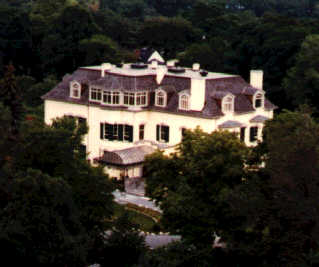
There were three houses on this site. The first two were built by William Baldwin. The last, the grand Victorian home still standing today, was built in 1866, by James Austin (picture lower left). His granddaughter, Anna, who lived in the house from 1942 until 1982, gave Spadina and its six-acre property to the city. It opened as a museum in 1984, complete with much of the Austin furnishings. It is maintained today by Heritage Toronto.

Dr. William Baldwin built a family home on the then two-hundred-acre property in 1818. He called it Spadina (pronounced spadeena), after the native term espadinong, meaning “hill.” In addition to being a lawyer and a doctor, William was an amateur architect, and he designed the house himself. It was a two-storey wood-frame building, somewhat plain, but very functional. Although the house was three miles from town, Baldwin declared, that the trip, often on foot, contributed much to his and his sons’ health. Over the years, Dr. Baldwin occupied a number of important public positions. He was a judge, Treasurer of the Upper Canada Law Society, and a member of the Legislative Council, in addition to carrying on both law and medical practices. He was a busy man, and in time the trip to the country home became less convenient, so when it burned down in 1835, and he built a home in town on Front St. In 1836, he had a smaller country home built on the old Spadina foundations. His first home in Toronto (then York) was at Front and Fredrick.
In 1866, James Austin, founder and president of the Dominion Bank and President of Consumers Gas, demolished the second Spadina and built the grand Victorian home surrounded by Gardens, groomed lawns, and majestic oaks which still stands today. The new house incorporated the fieldstone foundations of the 1818 Baldwin house. The most visible relics of the original house are the former front door, sidelights, and fanlight, which now form the back entrance. In 1889, James Austin subdivided the forty acres west of Spadina. Three years later he deeded twenty acres and the house to his son Albert. Albert added to the house several times including: a billiard room, ground-floor kitchen, palm room and glassed porte-cochere. In 1912, the north part of this property was sold to the city for a reservoir. Albert died in 1933. His second daughter, Anna Kathleen Thompson, lived in the house with her family from 1942 until 1982. Anna presented Spadina and its six-acre property to the city to be used as a historic house and museum. Spadina House opened in 1984, complete with much of the Austin furnishings, and it is maintained today by Heritage Toronto. Austin Terrace and Austin Crescent are also reminders of this leading Toronto family who occupied Spadina for four generations. (For more about Spadina and its owners, see “The Estates of Old Toronto” by Liz Lundell).
